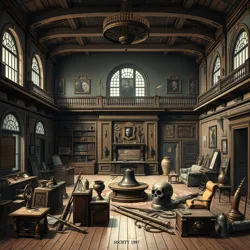Eastern Societies
The Eastern Societies were a network of clandestine investigative organizations operating primarily along the eastern seaboard of North America during the 19th century. Known for their methodical approach to unexplained phenomena and their integration of both scientific and traditional methods, these societies played a crucial role in documenting and investigating mysterious occurrences before the establishment of more formal investigative bodies.
 The grand hall of the Eastern Societies' main headquarters in New Haven Springs, circa 1865
The grand hall of the Eastern Societies' main headquarters in New Haven Springs, circa 1865History
Founded in 1823 by Professor Edmund Blackthorne, the Eastern Societies began as a coalition of academic researchers and Traditional Observers who sought to bridge the gap between scientific inquiry and folkloric wisdom. The organization established its first headquarters in New Haven Springs, which remained its primary base of operations throughout its active years.
Structure and Organization
The Societies were divided into several specialized branches:
-
The Archive Division - Responsible for documenting and preserving records of unusual phenomena
-
The Field Investigators - Active agents who conducted on-site research and investigations
-
The Pattern Analysts - Specialists who studied correlations between different unexplained events
 A collection of specialized investigation tools used by Eastern Society field agents
A collection of specialized investigation tools used by Eastern Society field agentsNotable Members and Cases
Among the most prominent members was Marshal Sarah Hawthorne, whose groundbreaking work in frontier investigation helped establish new methodologies for the organization. The Societies were instrumental in solving several notorious cases, including:
-
The Midnight Resonance event of 1850
-
The Vanishing Library incident of 1862
-
The Silent Bell phenomenon of 1868
Methodologies
The Eastern Societies developed the Integrated Observation Protocol, which combined:
-
Traditional folklore analysis
-
Scientific measurement and documentation
-
Pattern Recognition Techniques
Legacy
While the original Eastern Societies ceased formal operations in 1885, their methods and protocols influenced numerous subsequent investigative organizations, including the Department of Territorial Mysteries and the Frontier Forensics Movement.
 A detailed mapping system developed by the Eastern Societies for tracking unusual phenomena
A detailed mapping system developed by the Eastern Societies for tracking unusual phenomenaSee Also
- Traditional Observers
- Pattern Recognition Techniques
- Integrated Observation Protocol
- New Haven Springs
References
- The Eastern Societies: A Complete History
- Methods of the Traditional Observers
- Chronicles of the Unexplained